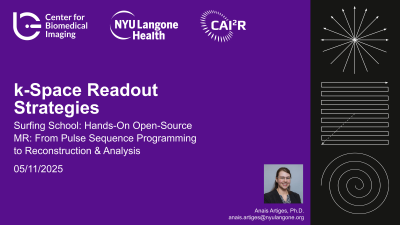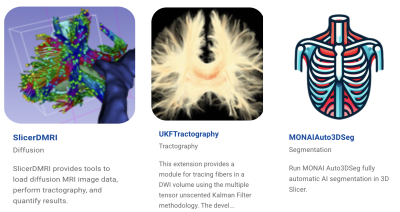Weekend Course
Hands-On Open-Source MR: From Pulse Sequence Programming to Reconstruction & Analysis
ISMRM & ISMRT Annual Meeting & Exhibition • 10-15 May 2025 • Honolulu, Hawai'i

| 13:15 |
 |
MR Sequence Fundamentals Using Pulseq
Andreia Gaspar
Impact: Pulseq is an open-source framework for MR pulse
sequence design. This course will show how Pulseq can be
used to create MR pulse sequences by combining different
building blocks such as RF pulses and gradients, along with
useful tools to implement different acquisition strategies.
|
| 13:45 |
 |
k-Space Readout Strategies
Anaïs Artiges
Impact: This course introduces several open-source tools
to design k-space readout strategies and focuses on mtrk to
implement echo-planar, radial, and spiral trajectories.
|
| 14:15 |
Offline Open Source Data Reconstruction
Qingping Chen, Maxim Zaitsev
Impact: This lecture introduces multiple offline
open-source data reconstruction approaches and the ISMRMRD
data format. Through hands-on exercises, participants will
learn how to convert Pulseq-based data into ISMRMRD format
and perform offline reconstruction using manual methods and
BART.
|
|
| 14:45 |
Hands-On Demo I |
|
| 15:05 |
Break & Meet the Teachers |
|
| 15:20 |
Online Open Source MRI Reconstruction Platforms
Onur Afacan
Impact: This talk explores online open-source MRI
reconstruction platforms, showcasing tools for efficient,
vendor-independent data processing. Learn how these
platforms enhance reproducibility, collaboration, and
innovation in MRI research.
|
|
| 15:50 |
MR Simulation Tools
Pablo Irarrazaval, Carlos Castillo
Impact: MRI simulation is key for research and teaching,
enhancing understanding of MRI physics, sequence
optimization, and acquisition testing. This course covers
signal models, software solutions, and open-source tools.
Using KomaMRI (Julia), we’ll explore its GUI and coding
features.
|
|
| 16:20 |
 |
Analysis of MRI Data Using the 3D Slicer Tool
Zora Kikinis, Ron Kikinis
Impact: This presentation showcases 3D Slicer, an
open-source MRI analysis tool, highlighting its applications
in whole-body mapping, segmentation, AI-assisted
diagnostics, and brain white matter tractography.
|
| 16:50 | Hands-On Demo II |
The International Society for Magnetic Resonance in Medicine is accredited by the Accreditation Council for Continuing Medical Education to provide continuing medical education for physicians.